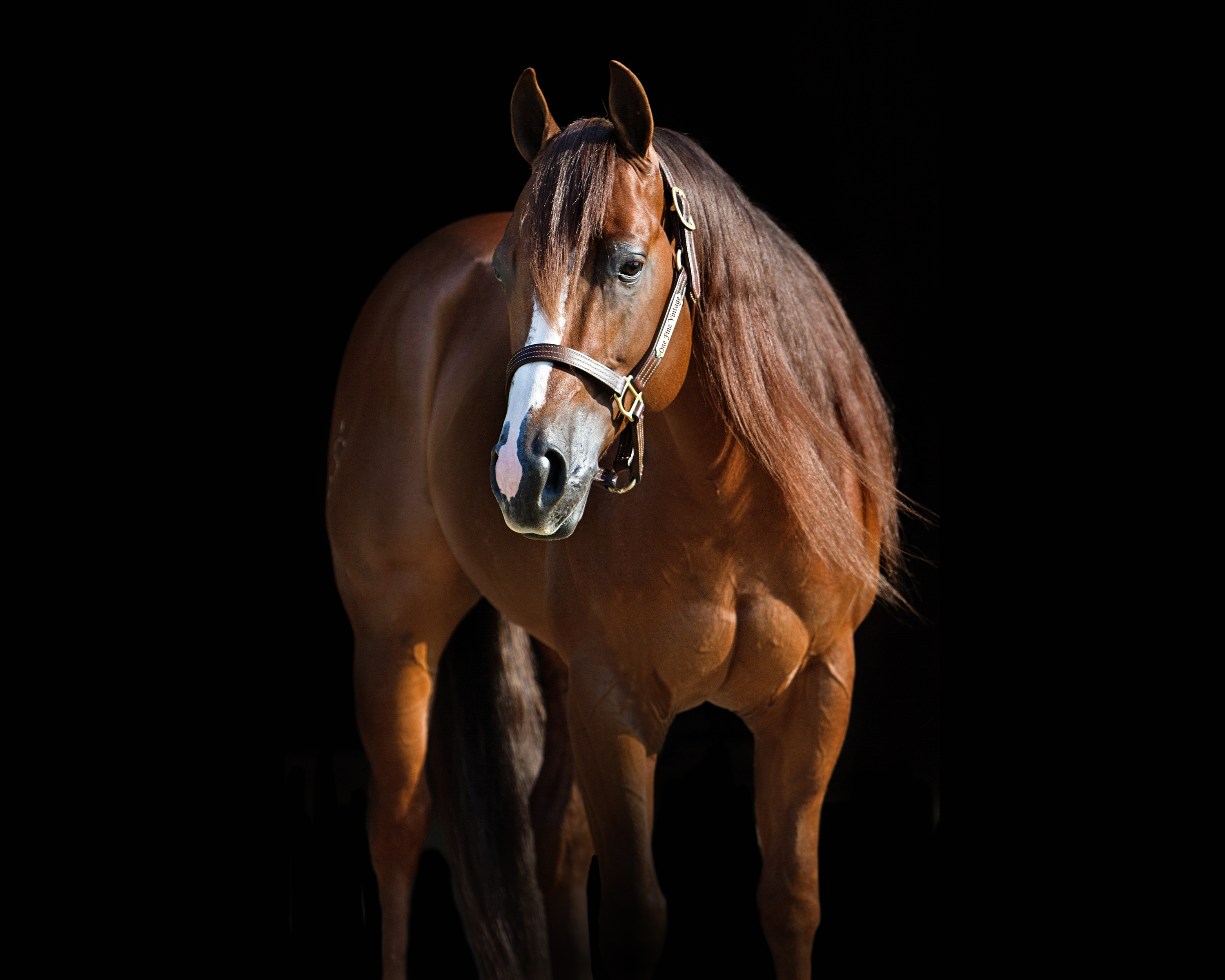When a sensational new, young stallion blazes a winning path through the Western performance horse industry’s futurity and derby events, the admiring and speculative “buzz” about him inevitably raises the question: how soon will he stand at stud?
Initiating or maintaining a stallion’s breeding career while he continues to pursue major titles in the show pen has become customary in cutting, reining and reined cow horse programs. Although the double- duty career path is not without challenges, many stallion managers say shrewd planning and common sense allow their multitasking males to flourish as both show horses and champion sires.
If the average equine gestation period was closer to that of chickens (21 days), canines (62 days) or even swine (114 days), the logistics of breeding horses for the competitive arena might be drastically different. However, the average mare takes 342 days to deliver a fuzzy-eared foal, and that is one of the shortest waiting periods in the drawn- out process of proving a sire. Factor in the time frame to establish the stud’s own show record, and the wait for his first foals to come of riding age, and “it’s at least a six- or seven- year commitment,” said Mary Robertson, of Plymouth, California, the breeder/owner of 2016 American Quarter Horse Association (AQHA) Senior Working Cow Horse Champion One Fine Vintage (One Time Pepto x Shiners Siena x Shining Spark).
That lengthy schedule is part of the moti- vation to launch a promising stallion’s breed- ing career as quickly as possible; in many cases, it begins years before he has retired from the show arena. Opening a stallion’s book with alacrity not only hastens the pro- cess of conceiving and growing foals to rid- ing age, it also allows him to capitalize on his success in the show pen before his hot-ticket flames subside.
“It’s easy to get ‘out of sight, out of mind,’ in the horse business,” said Jeremy Barwick, co-owner of Brazos Valley Stallion Station in Stephenville, Texas. “When they are out there winning and in the public eye, you’re going
to get a lot of interest in breeding the higher- quality mares when they’re still visible.”
He used current headline-grabbing 2013 stallion Hashtags (Metallic Cat x Dual Rey Tag x Dual Rey) as an example of the extended time frame between star performer and celebrity dad. “2018 will be Hashtags’ first breeding
season, and it will be years before the first colt shows. He will be a 10-year-old by then,” Barwick explained.
While many of the names on the Brazos Valley stallion roster are retired from the competitive arena, Barwick’s facility man- ages Hashtags and another new National Cutting Horse Association (NCHA) super- star – Metallic Rebel (Metallic Cat x Sweet Abra x Abrakadabracre), a 2012 stallion who was the 2017 NCHA Open Horse of the Year and NCHA Open World Champion Stallion. Both stallions spent the latter part of last year with one hoof in the show pen and the other in the breeding barn.
“When [Metallic Rebel] won the [NCHA] Super Stakes, we had collected him that morning. [It was the] same way with Hashtags. Tatum [Rice, Hashtags’ trainer] and I have been working together and com- ing up with a schedule,” Barwick said. He added that the two sons of Metallic Cat “are the only ones we’ve dealt with that have been showing and collecting. We don’t have too many that show and breed, so we don’t have any secrets to managing it. We collect them every other day. They get hauled back and forth to the trainer’s. We do try not to show them too far away, so we don’t miss breeding days.”
With Barwick’s stallion station, having trainers’ facilities and show venues all conveniently located in and around the Weatherford, Texas, area, helps simplify the schedules. “There are so many shows right here, we don’t miss anything,” Barwick said. In other parts of the country, where the equine industry is less concentrated, location can become a significant challenge. Robertson discovered that when she opened One Fine Vintage’s breeding book in 2015. The longtime cattle rancher and horse- woman was thrilled with how National Reined Cow Horse Association (NRCHA) professional Phillip Ralls, of Paso Robles, California, and nearby stallion station Goforth Equine managed “Vinnie.” Ralls trained and showed the 2009 stallion successfully, while the staff at Goforth Equine was meticulous about semen collection and preparation for shipment.
However, Robertson found she was less than satisfied with what happened to Vinnie’s semen when it was handed over to the freight company. The second stop from her location in California is, as she explained it, a notorious freight “black hole.” That left Robertson in search of solutions. “I felt a responsibility as a stallion owner. It was a reflection on me if the semen was not reaching the mare owner in a timely fashion,” Robertson said. She went into problem-solving mode. The discussion involved Ralls, as well as Ralls’ friend and fellow trainer, NRCHA Million Dollar Rider Corey Cushing, of Scottsdale, Arizona, who catch-rode One Fine Vintage to the 2016 AQHA Senior Working Cow Horse World Championship while Ralls awaited the birth of his daughter in Paso Robles. Ultimately, Robertson decided to move her stallion to Cushing’s barn in Scottsdale, conveniently located near anoth- er top-flight equine reproductive facility.
“If Corey couldn’t have taken him, then I would have had to find someone else in Texas or elsewhere, close to a good repro facility, who could also show him, maintain him and get along with him as well as Phillip or Corey had,” Robertson said. “Scottsdale Equine, where Vinnie is now, has frozen semen as one of their specialties, and they have been excellent to work with.”
Assisted reproductive technology, primarily cooled or frozen shipped semen, is pos- sibly the most significant factor in a stallion’s ability to maintain a busy show schedule and settle a full book of mares in the same year.
“We’ve been collecting and freezing Hashtags since October,” Barwick explained. “Frozen semen’s getting really big. [Metallic] Rebel is booked full, and Hashtags is booked full [for 2018], but we were able to sell some frozen contracts and breed more mares that way. And, of course, you have to have the fro- zen semen to send to Australia and Brazil. “As long as the stallions freeze well, it’s a good thing to have around, and the frozen semen is sort of an insurance policy on the stallion, too,” he continued. Shipped semen was not always a custom- ary procedure for American Quarter Horse breeders. In fact, the AQHA would not issue registration papers for foals conceived via shipped semen until almost 1990. The AQHA rule change came during a pivotal point when the iconic Hollywood Dun It (Hollywood Jac 86 x Blossom Berry x Dun Berry) was embarking on a sire career that eventually surpassed the $6 million mark.
“There are advantages for breeders today,” said Tim McQuay, the National Reining Horse Association (NRHA) Hall of Fame horseman who guided Hollywood Dun It’s career as his trainer and owner until the famous stallion passed away in 2005. McQuay started Hollywood Dun It’s breeding career in earnest in 1988, when the stallion was 5. “Dun It” had earned two major championships at the NRHA Derby and Super Stakes, making him in high demand among mare owners. At that time, the AQHA would only register foals con- ceived via “live cover,” defined as an actual mating between stallion and mare, or semen collection and artificial insemination with both parents on the same premises.
“When we started breeding Dun It, you had to have the mare on your property. You couldn’t ship [the semen]. It was a whole dif- ferent ballgame,” McQuay said.
In Hollywood Dun It’s first year of breed- ing outside mares, McQuay Stables was located in Maple Plain, Minnesota, on the cusp of the McQuays’ move to Tioga, Texas, in the fall of 1989. The stallion welcomed a healthy number of mares to his court during that first year in Minnesota, but his breeding book grew still more after he moved south.
“We did a little bit of live cover in Minnesota. When we got here [to Texas], I think he bred 80 mares that first year and over 100 mares the year after that,” McQuay recalled.
After the AQHA’s new policy on shipped semen, “I felt like it did have an impact on the breeding side. Living in Minnesota, there weren’t a lot of mares coming and going from Minnesota. You could get them here [in Texas] a lot easier. Now, it’s not quite a con- sideration.”
Article written by Stephanie Duquette for Quarter Horse News.

